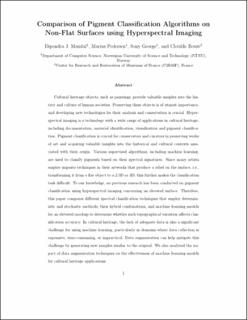| dc.description.abstract | Cultural heritage objects, such as paintings, provide valuable insights into the history and culture of human societies. Preserving these objects is of utmost importance, and developing new technologies for their analysis and conservation is crucial. Hyperspectral imaging is a technology with a wide range of applications in cultural heritage, including documentation, material identification, visualization and pigment classification. Pigment classification is crucial for conservators and curators in preserving works of art and acquiring valuable insights into the historical and cultural contexts associated with their origin. Various supervised algorithms, including machine learning, are used to classify pigments based on their spectral signatures. Since many artists employ impasto techniques in their artworks that produce a relief on the surface, i.e., transforming it from a flat object to a 2.5D or 3D, this further makes the classification task difficult. To our knowledge, no previous research has been conducted on pigment classification using hyperspectral imaging concerning an elevated surface. Therefore, this study compares different spectral classification techniques that employ deterministic and stochastic methods, their hybrid combinations, and machine learning models for an elevated mockup to determine whether such topographical variation affects classification accuracy. In cultural heritage, the lack of adequate data is also a significant challenge for using machine learning, particularly in domains where data collection is expensive, time-consuming, or impractical. Data augmentation can help mitigate this challenge by generating new samples similar to the original. We also analyzed the impact of data augmentation techniques on the effectiveness of machine learning models for cultural heritage applications. | en_US |

